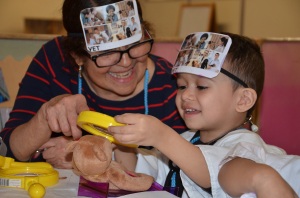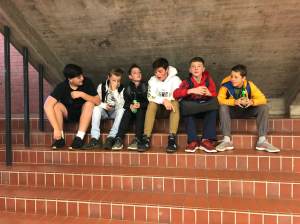Science
HawkWatch International: Using Hands-on, Real-life Learning to Improve Student Achievement
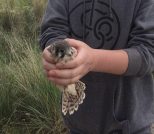
What were the goals of the project?
The goals of the “Cavity Nester Citizen Science Study” fall into four categories:
- To improve science proficiency in local high school students by giving students the opportunity to participate in real scientific research.
- To get students outdoors as part of their education.
- To support the community and create community awareness of cavity-nesting species.
- To learn more about the movements, environmental impacts, and causes behind declining populations of local cavity-nesting birds and what we can do to conserve these species.
How were these goals achieved?
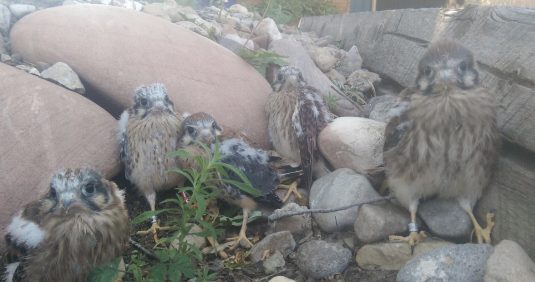
The project team hosted professional development workshops for teachers to introduce them to the project and explain how it supports the state’s curriculum. Lesson plans in biology, statistics, and environmental science were created. The lesson plans are shareable so the project can be replicated in other schools.
Students were trained how to properly monitor next boxes and cavities. HawkWatch International led trips for students to learn about and assist with banding birds. Utilizing their new skills, students monitored nest boxes and cavities near their school, conducted weekly habitat assessments, and recorded their data observations in field journals. They formulated hypotheses, analyzed the data collected, and formed conclusions about the birds being studied. Students presented their findings in a symposium open to their peers, families and the broader community.
What challenges were experienced along the way and how were they addressed?
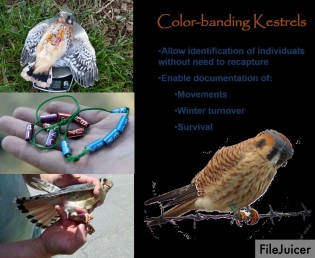
Like most organizations, HawkWatch International was deeply affected by the COVID-19 pandemic. Of the four schools originally involved, two had to drop the program and the remaining two temporarily closed. Since they were unable to physically visit classrooms or take students out to check nest boxes, they were forced to pivot to virtual visits. The project later transformed into a hybrid approach, providing a mix of virtual and real-life visits to classrooms.
Exciting plans for the future:
HawkWatch International hopes to eventually pilot this project outside of the Wasatch Front in Utah to reach more students and transform them into conscientious environmental stewards eager to take an active role protecting the habitats of cavity nesting birds.
Additional resources:
Environmental Science Pathways: Empowering Students To Find Solutions To Protect The Planet
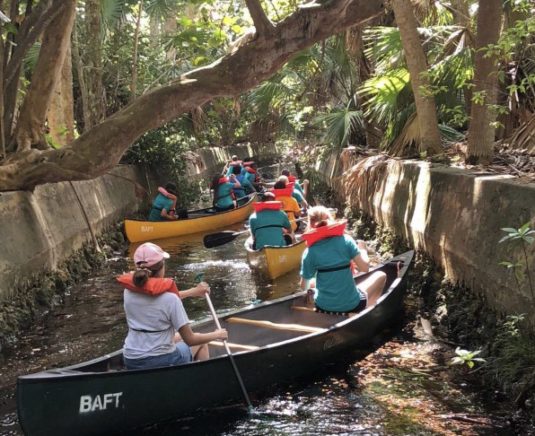
School aged children have experienced growing up in a world where we discuss and hear the current status of the global climate. What if we empowered our students to find solutions to protect the planet? The project team at South Plantation High School in Plantation, FL did just that through their Environmental Science Pathway project. With the support of the McCarthey Dressman Education Foundation, they sought to develop a curriculum that is guided by the themes of reducing the carbon footprint, water issues, and human population issues.
What were the goals of the project?

The project team wanted to instill environmental stewardship in their students through their comprehensive Environmental Science Pathway Curriculum. In doing so, students will become more engaged in their coursework and gain industry-identified content knowledge and employability skills. To accomplish their goal, the team recognized their teachers needed time to work collaboratively to identify and address student challenges, develop shared goals for the pathway, and gain the skills necessary to implement the developed goals. They planned to continue with the Environmental Science and Everglades Restoration Professional Learning Community (PLC) and to collaborate with the Environmental Advisory Committee to train and support teachers.
What progress did they make to their goals?
Even with schools going virtual, the project continued on.
The PLC met virtually and in person on a regular basis. Members of the community were trained in new software and e-learning platforms and supported each other by sharing their new skill sets. Chemistry and Environmental Research teachers joined the magnet team.
The PLC team hosted monthly campus beautification days where the school’s outdoor classroom gardens and green spaces were maintained while providing training for faculty and teachers.
Teachers participated in professional learning by attending virtual workshops and on campus events. Students were provided with opportunities for community and civic engagement outside of the classroom through virtual symposiums and conferences.
Cambridge courses that are in alignment with the Environmental Science Pathway were infused into the magnet course selection. Environmental programs/ lessons and field trips were executed virtually, on campus, and at home with the help from their Environmental Advisory Committee across all grade levels. Most programs included an outdoor learning component. Teachers provided hands on learning opportunities that exceeded curriculum standards for in-person and virtual students.
What challenges did they face and how did they address them?
The greatest challenge for the project team was learning how to use the online learning software in which all school operations had to take place. The grant team learned a new set of tools and a very high level of patience as technology is a great educational vehicle until it doesn’t work or students cannot access.
The team also recruited an alumnus to provide additional technology support. The Environmental Advisory Committee shifted their work from the field to a virtual Environmental programming for students and teachers. The traditional Magnet Open House was in the style of a drive-thru using QR codes.
Another challenge the team faced is not being able to implement the PLC’s common research paper and lab report format due to teachers working in isolation and science labs being limited.
What will they do next?
The PLC teachers have collaborated with the Environmental Advisory Committee to come up with ideas for infusing the newly created virtual programming into their traditional project based learning and field trips. Cross-curricular connections, science research, and hands-on lab investigations will be part of the Environmental Science Pathway Curriculum.
The Everglades Foundation’s literacy training is being planned as professional development for all magnet teachers. In doing so, the project team hopes to become an Everglades Champion School that showcases the project’s success!
Additional Resources
Cavity Nester Citizen Science Study: Field Biology Boosts Math and Science

In 2012, HawkWatch International (HWI) created a school-based “Cavity Nester Urban Bird Study” in partnership with the Salt Lake Center for Science Education (SLCSE) in 2017. Designed to be a student-led expansion to the project, the study has allowed them to start studying all cavity-nesting birds living in urban settings.
In this project you’ll learn more about how citizen science increased student awareness related to cavity nesting species, specifically the American Kestrel, a species in decline across much of its natural range. Both the Salt Lake Center for Science Education (SLCSE) and Farmington High School participated.
What were the goals of this project?

The goals for this project were to collect data that allowed an understanding of the
survivorship and reproductive success of the American Kestrels, and to reinforce high school math and science concepts by allowing students to gain hands-on experience in field biology. Students would complete a field journal where they would record observations, collect data, and draw conclusions. They would also present their findings at a symposium open to their peers, families, and the broader community. The journals and presentations were to be shared to draw attention to the project and its benefit to local students.
How did they approach the project goals?
This goal was achieved through several visits to each classroom, a total of eight visits — focusing on project and monitoring procedures, natural history information about American Kestrels and other cavity nesters, nest check ethics, and how to determine the age of nestlings. They brought in live birds to connect students to the natural history of raptors, as well as actual monitoring equipment for the students to become familiar with the technology used and to ensure a comfort level with the process.
Participation in Large Scale Citizen Science
Working directly with the students and teachers in the classroom and in the field to practice and understand the necessary protocol to monitor the nest boxes, capture photos and videos of the activity in the boxes, and to enter their nest box data. Project leaders worked with students and teachers to learn how to use the technology employed to check the nest boxes and how to use the data platform, Jotform, to enter the data. And they participated in the regular monitoring of the nest boxes.
Journaling for students and lesson plans for teachers
They developed sixteen lesson plans related to both math and science, as well as a journal developed with teachers for students to keep track of their own data. The journal also included some valuable reference information about the American Kestrel and the nest box procedures.
How did they achieve their goals?
Through the project, three visits were offered to SLCSE and five visits to Farmington High School. These visits helped develop relationships with students and teachers. At each visit, they established an aspect of the project, covering the concepts of natural history of cavity nesters, procedures for the project, and practiced how to use the technology and equipment necessary for the project. This was accomplished using Powerpoint presentations and actual equipment in the classrooms.
Additionally, they went out with the students and teachers on nest box checks to make sure they understood the process and equipment use.
What was the impact of this project?
Here is a quote from one of the participating teachers.
“We have a student at our school who is autistic and struggles socially and academically. In an effort to provide opportunities for students of all abilities, we’ve invited this student to participate in our nest box monitoring because of his love of birds. Each week we checked the nesting boxes, and this student was required to complete all of his homework to attend because he was not actually in the statistics class. He did not miss a week. He is constantly telling me about the new information he is learning about random raptors. Just today he went out with his group to check his assigned boxes and there were some people there from Hawkwatch who were kind enough to point out some nearby raptors. His enthusiasm about birds keeps growing.” -Emma Chandler, SLCSE science teacher
Working on this allowed educators to develop and execute an in-depth citizen science program. They often only see students for one class period and then part ways, but with this project, programs were offered for teachers and students on a regular basis throughout the semester. They were able to share their passion with them and engage students in a way wherein they started looking forward to checking boxes and developing “relationships” with the nestlings in their assigned boxes. Having the students see science careers that happen outside the lab and working directly with scientists was beneficial for students in considering higher education and career opportunities in science.
What challenges did they encounter?

They budgeted for 12 cameras for Farmington High School, but had to allocate 4 of those cameras to SLCSE due to wear and tear on the older cameras. In an effort to mitigate this challenge next time, they plan to meet with the administration of Farmington High School to encourage support for allowing the students to check boxes during school hours. They will also ensure there is a camera and set up for each group, rather than a certain number per school.
The other challenge faced was ensuring timely and accurate data entry by the students. A greater focus was needed in emphasizing the importance of entering the data in a timely manner from the nest box checks. The same is true for the accuracy of the data entry by the students. A fair amount of time was spent by staff going back and verifying data entries with students and/or teachers. In the future, they plan to practice data form entries more diligently with the students prior to actually checking nest boxes in an effort to prevent these kinds of challenges moving forward.
Explore Citizen Science
Full STEAM Ahead with Project Based Learning
All aboard and Full STEAM Ahead!
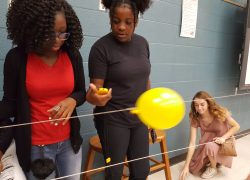
The educators over at Bates Middle School in Sumter, South Carolina have been working hard laying tracks for the past year in order to bring their exciting project to fruition. By combining Project Based Learning (PBL) and a curriculum focus on Science, Technology, Engineering, the Arts and Mathematics (STEAM) and working with local businesses they are hoping to create a new generation of students who are prepared to be in an agile and competitive work force. One of the brilliant concepts behind this project is that nothing exists in a vacuum. You can’t well understand engineering if you don’t have a good handle on physics. You can’t code a videogame without understanding the underlying code. And you certainly can’t have music without math.
The Full STEAM Ahead project aims to remove the traditional isolation of subjects through the use of the “Critical C’s” of Collaboration, Cooperation and Communication which are emphasized with project based learning through interdisciplinary activities.
Now that they are a year in, let’s see what has transpired.
Bates teachers, led by the Transforming Learning Together (TLT)
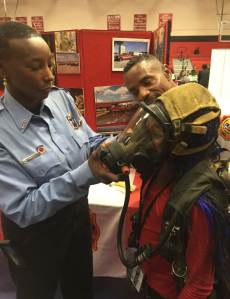
mentor teachers, in the first stage of this initiative begun by identifying large-scale student learning goals for the year. They then researched new teaching approaches in order to integrate STEAM and Project Based Learning to help them achieve their goals, along with developing “action plans” for each year’s practice. The belief was that art can spark creativity in young scientists and engineers, develop observational abilities, and strengthen collaborative skills. One of the guiding questions for this project is ” How can we improve instruction, pedagogy, and student learning across the curriculum through the use of STEAM and PBL?”
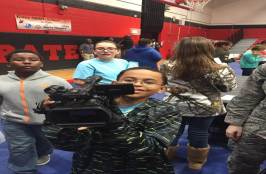
So how do they propose to do this?
They began by having their trainers and the TLT team attend a PBL and STEAM workshop that spaned six sessions. This team returned to Bates to lead the entire staff through a STEAM Project Based Learning activity in order to familiarize everyone with the methods. Teachers investigated and utilized critical inquiry to work through this challenge. The thinking was that teachers will experience everything that the students do, giving them the tools to help elevate the projects as well as answer previously unanticipated questions. Teachers then guided students through one PBL unit in the first year of implementation.
A year in… where are they now?
They started off by providing professional development to their teachers during the first semester of the school year. STEAM lessons were developed to be a part of the regular curricula as well as embedded in Project Based Learning. The second semester brought about school-wide PBL units. Then on March 24th, there was a school-wide PBL Kickoff to begin the grade level units. This is where things really began to take off. For this initial thrust into the unknown they gave each year a different subject field to dig into. Sixth graders explored the guiding question: “Are animals placed in captivity at an advantage or disadvantage than those in their natural habit? Why/ Why not?”

The kick-off was a field trip to the Riverbanks Zoo. The 6th graders researched the question and created suitable habitats for animals of their choice. The 7th graders explored the guiding question: “How can we be prepared for the unexpected?” Dealing with the preparedness for natural or man-made disasters was the focal point. The Red Cross, Fire Department, EMS, Disaster Management, Police Department, Shaw AFB and Salvation Army each set up a station to explain their role in disasters and how the community can prepare for disasters in the future. Students researched a disaster and prepared community service presentations on disaster preparedness. Eighth graders explored the, very relevant, guiding question: “Can separate be equal?” This question dealt with the Civil Rights movements of 1960 -1990. Guest speakers, Nathaniel Briggs (Briggs vs. Elliot) and Artrell Benbow (civil rights activist in Summerton and Sumter) spoke to the students of their personal experiences. This culminated with the 8th grade Drama class presenting a skit about the infamous Orangeburg Massacre. Students then rotated rooms to watch films about civil rights, explored civil rights virtual museums, and participated in gallery walks. Students researched the civil rights eras of 1960’s through the 1990’s and created projects to address the guiding question. The PBL classes occurred every Tuesday and Thursday beginning March 28th and ended in a PBL Excellence Fair held on May 4th at 6:00 pm at BMS to showcase student work and presentations.
What are some challenges facing STEAM/PBL learning?
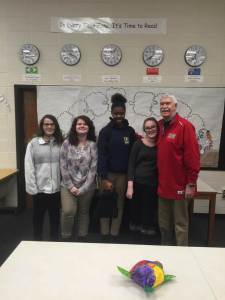
For as exciting as this method of PBL learning is, and it’s clear that it’s starting to work; students and teachers on the whole are more engaged in their study areas… it’s not without it’s challenges. One of the biggest cited in the report is that not all of the teachers have bought into the STEAM /PBL concept. This makes communicating those ideas to students that much harder. Further professional development is needed in order to ensure more participation by teachers. They have also had some difficulty setting up model classrooms so we are hoping teachers observing other teachers will assist in this. But as more teachers undergo professional development and find the merit in this method of teaching the easier it will get. And year two has some exciting things in store for the students. One word: Robots. We look forward to hearing about their experiences with Robots.
How might Robots, cross-cultural references and civil rights intersect?
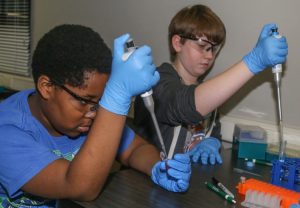
Let’s mix up that engineering and art a bit, shall we? The term “robot” came from a Czech play called Rossums Universal Robots and is derived from the word “robotnik” which means slave. It’s about a robot who is forced to work for a shady company that then rebels and leads to the extinction of the human race. It’s bleak, but not without hope. But it’s a good lesson and a challenge for students on how we should be thinking about a newly created servant class. Just some food for thought.
Learn more
- STEAM, not STEM
- STEAM Rising: Why we need to put the arts into STEM education
- Project-Based Learning: PBL is a dynamic classroom approach in which students actively explore real-world problems and challenges and acquire a deeper knowledge
- Project-Based Learning: Students actively investigate solutions to complex, long-term challenges, often in groups
The Village Science Project: Reducing Barriers to Science Education in South Sudan

While there are always needs in the schools in our own country, it is important to remember that other countries have students that have the same potential but lack even the basic resources available to many U.S. students.
This is what Candacia Greenman is aiming to address by working with the Loreto Primary School in Rumbek, South Sudan. The Village Science Project (VSP) aims to use an inquiry-driven, hands-on and play-oriented approach to improve access to high quality science education for over 200 disadvantaged students over a 3-year period in this MDEF funded academic enrichment project.
How can educators address barriers to high quality science education?
VSP intends to target the four main hindrances to science learning in their community in order to better serve the students:
- Limited resources for practical, inquiry-driven science exploration
- Poor English language acquisition
- Little community engagement
- Psychological barriers to learning
VPS’s proposed addressing these in the following ways:
- Providing students with the resources needed for science exploration through the use of science experiments and engineering and robotics projects.
- Implementing techniques to improve English language skills in science learning by promoting reading through tablets, facilitating peer learning experiences and encouraging student presentations through science fairs
- Stimulating community engagement through science fairs combined with field trips and career talks from local community members.
- Creating low-stress environments for our students, especially our girls to become interested in learning science (students are also given opportunities for “tinkering” or “free play” with science kits through the formation of an after school “tinker club”)

How can teaching methods improve students’ love for science?
Loreto Primary School serves over 600 students, with an emphasis on girls’ education and VSP will benefit about 200 different upper primary students over 3 years. The students live in a community with limited access to electricity and potable water and currently, classes are conducted outdoors under trees.
Most of these students never get a real chance to find a love of science because it’s taught almost exclusively in a theoretical, teacher-centered manner. As such, VSP is ground-breaking because of its use of a more hands-on and child-centered methodology to elevate student learning. They’ll do this by keeping a strong focus on inquiry-driven science exploration, which will help these students to develop their critical thinking skills. VSP will also deepen students understanding of, and interaction with the local physical environment as well as addressing social issues that adversely affect science education such as gender inequity, trauma-induced stress and poor community engagement.
At the end of year one the educators working on the VSP conducted initial baseline assessments of science performance and interest of Primary 5 and Primary 6 students after the following programs were implemented:
- Teacher demonstrations
- Laboratory exercises/activities
- Robotics and engineering projects
- Tablet usage
- Mathematics manipulatives usage
- Science fair
- Career talks
- Field trips
- Tinker Club
Revealing effective science and math teaching
The VSP team members have conducted baseline assessments in both science and mathematics enabling the teachers to tailor the rest of their programs according to how best to serve the students needs. In light of a mathematics assessment revealing gaps they’ve launched a mathematics intervention program targeting student understanding of number operations for Primary 3 through Primary 6 students. All teachers have adapted their teaching programs to allow for more time for Mathematics instruction and they have expanded their focus on number operations.
In addition, all of the primary school teachers attended a month-long training workshop to learn how to integrate demonstrations into their lesson plans for effective science teaching. In order to maximize the use of the science teaching aids, they expanded their focus to include demonstrations in Electricity, Magnetism and Weather modules.
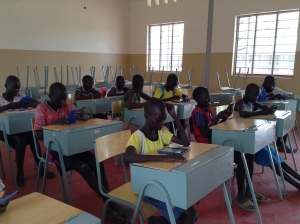
Best of all, afterschool programs to supplement students’ science education have also been implemented. In these programs, the students use science kits to expand their learning of material covered in their Electricity, Magnetism and Weather modules. Those aren’t the only exciting things going on after school for Loreto Primary School students.
VSP has also introduced programs to introduce students to engineering principles and robotics. In these programs, students have been using Engino engineering blocks to build simple machines and learn how to code using the Lightbot app as a first step towards understanding robotics. The engineering afterschool program encompasses the proposed ‘Tinker Club’ in which ‘free play’ is encouraged and students build simple machines of their choice. Students are also being provided with tablets to use in the afterschool programs to aid them in their mathematics and science courses.
One of the most exciting additions have been the science fairs which give the students a place to shine in front of Teachers, parents and other community leaders also attending the event. The science fair focused on energy and engineering and students gave presentations on the design of solar toys, the basics of electricity, and the design and utility of simple machines.

One of the greatest feathers in the cap of the VSP project is that all of their after school programs and the science fair were conducted in English and has resulted in a vast improvement in English comprehension. In addition, students have learned how to use technology and the basics of coding through the use of tablets. Their teachers have reported that tablet usage has also helped the students with Mathematics anxiety.
Lessons learned in academic enrichment
The accomplishments of this project have not come without challenges. The VSP team have reflected on ways they can improve their program in later years. Their biggest challenge was the field trips due to security concerns. As a result of this challenge, they have shifted their focus and are currently designing a “Mathematics and Science for Life” program in which students will attend weekend sessions to learn how mathematics and science are useful in everyday life. Being able to adapt and shift strategies in response to challenges is a necessity for success for a program like this.
The VSP team also learned the difficulties of relying on applications that are not as readily available on the international networks. Google Play is not enabled in South Sudan. As such, all apps must be pre-loaded before transportation to Rumbek. Unfortunately, this means that updates cannot be installed as needed. Furthermore, a lack of consistent and fast internet access has limited the utility of many apps that would be very useful for the students. And in addition to these challenges, having electricity in the classroom has been an issue. As such, they recently invested in solar energy to provide electricity to their school campus and are have installed solar electricity panels for our primary school which will improve their internet access.
All in all, it sounds like some really exciting things are going on with the VSP in Rumbek. They’re swinging with the punches and adapting when necessary. The McCarthy Dressman Education Foundation is excited to see where they go in the years ahead. If they succeed, other schools in the region will benefit enormously from the pedagogical strategies that these educators are pioneering.
Learn more about the topics in this post
- Science and Math Education for Development
- SIAM: Developing Mathematics in the Developing World
- Science Education in Developing Countries
- Revealed: World pupil rankings in science and maths
- Redefining education in the developing world
Aquaponics: Growing Our Own Food Sustainably
Learning how to grow food engages culinary students and harvests real-world science in this featured project.
In an age of environmental unpredictability and rising cost of living one thing not being discussed enough is self-sustainability. Understanding how to grow and prepare one’s own food is an incredible life skill to develop, regardless of one’s chosen profession. This is something that Michael Kosko and the educators at Al Raby School for Community and Environment, Chicago, IL are taking on right now through their program “Aquaponics: Growing Our Own Food Sustainably.” By teaching students how to grow their own herbs and vegetables, alongside certain types of fish they are hoping to create a program that produces students mindful about their environment and who can also cook up a decent, healthy filet of fish. This program will also provide students with the opportunity to explore issues of food justice and food deserts which many students experience within their communities.
My students are building aquaponics units next week. Plans from @lifehacker, funded by the #teacherincentivegrant pic.twitter.com/iiUhA0FBkV
— Michael Kosko (@MrKosko) January 25, 2015
//platform.twitter.com/widgets.js
Recipe for Success
This project is unique to the Chicago area. While there are many culinary and horticulture/agriculture programs in the city, Al Raby will be the first to combine these two types of programs into one. The Office of CTE (career and technical education) Programs provided equipment for the culinary lab. In the grow lab, students will grow salad greens, kale, and various herbs while taking care of tilapia and koi. Eventually, this program is looking to partner with local businesses to sell the student harvest. In the classroom, students will study the life cycles of plants and fish and the optimal way to grow both. Since this class will be heavily rooted in the scientific method and student inquiry, students will also study how different variables affect plant growth including temperature, light intensity, nutrient/chemical levels, water quality, diseases, and aquatic pests. And since no pesticides or synthetic fertilizers are used, all produce grown in the lab is classified as organic according to the USDA National Organic Standards Board (NOSB) definition.
Building a Grow Lab and Disseminating Learning
Ultimately, the goal of the project was to build out a grow lab in the school to support their preexisting culinary/food science career and technical education (CTE) program when those classes began in September 2016. Accomplishing that meant getting the grow lab up and running, which they did, leading to a bountiful harvest in May. Students who took the vegetables home came back with rave reviews from family and friends.
Currently they are working with the Garfield Park Conservatory, to create a teen docent program made up exclusively of Al Raby culinary students. Fifteen of their freshmen students interviewed for ten spots on the inaugural docent team. During the summer, these students work to create educational experiences for area elementary students and during the school year they will be released from their culinary classes once a month to lead tours for second and third graders.
Along with those benefits, this past summer the selected students ran experiments in the grow lab with Akilah Henderson, the Student Engagement Coordinator at the Conservatory. Under Akilah’s guidance the students will tracked the growth of crops on the conservatory’s farm and in the lab, building on the Botany students’ work from the past semester.
Meeting Challenges and Planning for the Future
They were not without difficulties. Unfortunately they discovered too late that the district requires schools to obtain special permission to raise fish. Because of this, the first round in the lab had to do without the fish. But David Blackmon, the program coordinator for all the culinary CTE programs throughout the district, toured the lab earlier in the month and is working with central office to obtain permission for Al Raby to start raising tilapia and koi next school year. Fortuitously, fish can easily be added to the current units in the lab with no modifications once permission is obtained.
Regardless of the fish-hiccups it sounds like the students and educators at Al Raby are off to a great start. It sounds like before long they’ll be swimming in so much fish and so many vegetables they’ll have have trouble giving them away!
Plans for a dinner for district leaders and community stakeholders are in the works to share the success and help others savor the impact of the project.
Learn more
- Nonprofit hopes to spread aquaponic farming to schools across the country (PBS)
- Aquaponics STEM Food Growing Systems in the Classroom (Aquaponics USA)
- Classroom Gardening: Hydroponics or Aquaponics (Bright Agrotech)
- Aquaponics Education for Schools | Systems & Curriculum (Ecolife Conservation)
STARS: Real world inquiry excels to new heights at Research Ranch

Science, inquiry, project-based learning, and relevance take center stage in STARS.
At a time of such ecological uncertainty, when some of our greatest minds have given us 1000 years as a species until extinction, one thing is abundantly clear: the study of celestial bodies, near and far, has never been more important. And while 1000 years may be a bit far off to even comprehend, it behooves us to broaden our understanding of our neighboring planets in stars in hopes that when the time comes for us to leave our terrestrial trappings behind, we’re ready.
This is exactly what educators at George West High School have been working on for the past two years with their innovative STARS (South Texas Astronomical Research for Students) program.
“It has widely been assumed that scientific research and especially astronomical research was an endeavor to be pursued at the university level, and even then primarily by graduate students, certainly not at the high school level. STARS challenges that notion.”
-Kenneth Zeigler
Research Ranch Cultivates Learning
STARS is not limited to astronomy. At Research Ranch, tiny ranch by Texas standards of only 34 acres, introduces students to real research in the following fields of study:
- Astronomy
- Solar energy to electricity conversion
- Ecology
- Materials engineering
- New techniques in ranching (the solar ranch)
According to the report, in the first two years of this project all the areas above demonstrated tremendous progress in regards to research. Current efforts continue to focus the project primarily on astronomy, materials engineering, and solar energy.
A Converted Marching Band Trailer becomes a Mobile Astronomical Observatory
One of the most exciting developments of the past year was the STARS observatory telescope coming fully online to fully begin the program. It’s housed in the Mobile Astronomical Observatory, an 8 by 16 foot, 30-year-old converted marching band trailer.
This year saw the final steps of the transformation into a scientific research facility. Even receiving a brand new coat of paint and its official logo as the school year began.
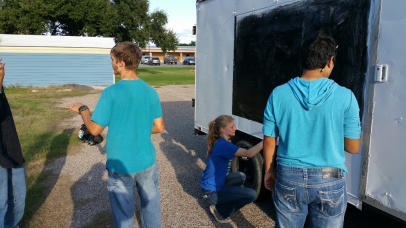
The mobile observatory is divided into a control room and telescope room section. Most of the student researcher’s time is spent in the control room which is climate controlled.
The primary instrument used this year with the telescope was the thermoelectrically cooled CCD camera that could be used to take timed exposures of the heavens as well as make measurements of star brightness at a variety of wavelengths. This opens the possibility of making measurements of color and surface temperature of stars or the shapes and rotational periods of asteroids. The student operators, CCD camera and main telescope are shown in the slideshow below.
Rocketry Club Qualifies for National Competition
The observatory isn’t the only thing to be excited about. An unexpected offshoot of the astronomy program has been a new rocketry program. Interest in the mobile observatory inevitably led to an interest in all things space, and it led students to pursue the Team America Rocketry Challenge. Two teams from George West High School participated in this nationwide competition. The challenge was to build a rocket that would carry two raw hen eggs to an altitude of exactly 850 feet and return them to the ground undamaged in a flight time between 44 and 46 seconds. This is a most difficult task and one of the two teams (Cloud 9) qualified for the national competition.

Solar Voltaic Arrays Support Real World Agricultural Inquiry
The solar ranch is another reason to celebrate this program. Junior Ryan Repka has been working on two different designs for photovoltaic arrays. The first one is the semi-active array. The first panel will be finished before the end of the school year and will be installed during the summer of 2016 with the entire photovoltaic array to be completed during the fall 2016 semester. At that point, Ryan will begin a semester long study as to the best ways to maximize efficiency, from panel positioning to water cooling of the panels.


Through repositioning of photovoltaic arrays as part of the STARS research project, an additional 15-20% solar power efficiency can be realized.While this project exceeds expectations for high school students, it continues to expand student learning opportunities.
In terms of agricultural and ecological research, the project is just beginning to make progress. In fact, an intriguing future project is taking shape. Not far from the observatory site and solar ranch, the first trees of a citrus orchard have been planted. The observatory site is a bit north of the main citrus growing region of Texas. Being on a hill out of areas of cold sinking air help, but this area is subject to serious killing frosts about one year in four. To combat this problem, the students and educators plan to develop what they are calling a microwave defroster. This system could be used to prevent frost damage on citrus but would be even more useful on more sensitive winter vegetables such as lettuce. They plan to initiate a pilot project for this device no later than the winter of 2018.
It truly is an exciting time to be a student or a teacher participating in the STARS program at George West High School. There’s something very powerful about teaching and learning while simultaneously working for a better future for all humans.
Learn More
App Development and 3D Printing for At-Risk Youth increases Learner Confidence and Problem Solving Skills through Maker Magic
“Failure is a good thing in the development world, it teaches developers quite a bit.”-App Development Instructor
Becoming good at anything is a process. Educators know that students must develop confidence in the face of mistakes and failure, because they are truly an opportunity for learning. As Bob Lenz explains in Edutopia, “failure is an opportunity for students to receive feedback on their strengths as well as their areas of improvement — all for the purpose of getting better. When reframed as a good, constructive, and essential part of learning, failure is a master teacher,” (Failure is Essential to Learning, 2015).
In this report from App Development and 3D Printing for At-Risk Youth, you’ll hear more about how a partnership at Helensview Alternative High School in Portland, Oregon, helped students build confidence and work through failure by developing 3D printed objects and apps. By integrating “maker” culture which focuses on DIY (do it yourself) engineering, students gained confidence and developed problem solving skills. Learn more below!

Why support students in making and developing?
According to the funding proposal “When Google released their diversity stats it came as no surprise that nearly every field was dominated by white men” so with an interest in building interest in STEM careers, the non-profit organization ChickTech partnered with high school teacher Brian Granse to offer making opportunities in the classroom. ChickTech, which focuses on increasing gender diversity in technology through hands-on activities, supported Helensview educators in pursuing the following project goals:
- Provide at-risk students from Helensview Alternative High School with technical workshops
- Allow students to create unique 3D printed objects and apps
- Improve students’ confidence and interest in learning
- Create lessons that can be improved upon next year and shared with others
How can you use 3D printing and app development to enhance learning and student interest?

In this project, students were offered access to workshops instead of their regularly scheduled classes. For five weeks, regular 3 hour sessions were offered on Tuesday and Thursday afternoons. Initially, others in the school were concerned about the length of the sessions, given that most students had a hard time staying involved in 45 minute classes. As the students became engaged and interested, the school community was pleasantly surprised. Students were not only engaged, but some stayed after school had ended to continue to work on their projects, a feat the report called “unheard-of” for this school.
Workshops focused on two types of making, 3D printing and app development.
3D Printing Layers Learning in Geometry and Measurement with Practical Knowledge
In the 3D printing workshops, students created multiple unique 3-D printed objects they could later take home. These included:
- personalized name plates
- custom-shaped containers
- bracelets (also personalized)
- toy cars

The workshops supported the students in learning important concepts and skills for 3D printing (explained here by 3Dify) over the course of creating the various designs, including:
- creating 3D objects using basic sketch tools such as rectangles and circles
- customizing objects with text
- adding loops to an initial sketch to build a 3D object in successive layers
- using a computer to navigate three-dimensional space
- drawing complex sketches using geometry for practical objects such as containers
- creating objects based on real-world measurements
- creating objects with functional wheels
- sketching flat designs onto curved surfaces

The more that the students learned, the more creativity they expressed. The most rewarding project for the instructors was the most complex and required the students to integrate all of the skills they were learning over time. By creating a custom built car model including customized mufflers, tailpipes, headlights, spoilers and wheels the students moved way beyond 3D modeling and into the real world – their designs even had to follow strict guidelines in order to be printable. “By the end, the students who clearly wanted to be designers stood out as did the students who wanted to be the builders of 3D printers” (Project Report) highlighting the effectiveness of the workshops focused on these skills.
App Development Builds Confidence in Problem Solving and Learning from Failure
The second series of workshops focused on app development, which also required the students to demonstrate complex problem solving skills. To get started, students followed a tutorial to learn TouchDevelop, an app creation tool, before brainstorming ideas for apps they would like to create. Once they decided what apps they wanted to develop they worked in teams to create them.
Learning how to develop apps required the students to practice and apply the following skills:
- problem solving
- content creation
- following directions
- managing time
- working in teams
Each app went through several iterations over the three week period. Two groups worked on two separate apps. One app taught about telling time on a conventional handed clock and the other taught about geometric math formulas that many students must learn for exams. Students also worked to incorporate a quiz feature that would test the app user’s knowledge of the content presented. Through trial and error, students learned about the complexity of app creation. According to the report, “Because the focus was on the process and not the finished app, students were able to explore many issues involved in developing technology for a wide audience of users. Students expressed how appreciative they were of apps that effectively solved problems as they understood how difficult it was to create and maintain a bug-free application.”
Although students came into the app creation workshops enthusiastically having already explored 3D printing, they needed a fair amount of encouragement to work through the challenges of app development. The instructor of the app development workshops wrote:
“Successful developers (app or otherwise) have a unique ability to manage frustration well, and this skill really only comes with practice and time. I did see students give up quickly at first. There was a lot of waiting for instruction rather than self guided discovery. My impression was that there was still a lot of fear attached with “failure.” Failure is a good thing in the development world, it teaches developers quite a bit. After explaining that to students, they were more inclined to try and try again without feeling frustrated. I noticed around this time, too, that students were starting to share what they were learning. If a student came up against the same bug or error message as another student had previously, it became an opportunity for those students to collaborate, and learn from one another.
We are fortunate enough to live in a world where apps are plentiful and most are very well made and fun to use. Once students learned how complex and time consuming the process really is, they were initially put off by the amount of work that loomed in front of them. Students came up with ideas that were really fun but ambitious. And once the hard work started, it was a struggle to keep the students motivated. The enormity of making an entire app that looked as flashy as something already on the market started to seem like a “why bother” scenario. But, by breaking our apps into smaller, more manageable pieces, the students had consistent success with creating new features.
There are almost infinite solutions to solving even the same problem in computer programming, so we really tried to communicate to the students that giving up is not an option. There is always something new to try. At points I know the students would have preferred to give up altogether, but I did see them gradually start to shift away from one problem to tackle another-rather than abandoning the entire project altogether. That is a very evolved problem solving technique, and one that even professional developers don’t learn until years on the job.”

Celebrating Results of a Maker Nurturing Project
After 5 weeks of workshops, the project team held a celebration party for all students, teachers, school and school representatives, and the workshop instructors. During this celebration, students showed off their projects and received feedback from the community.
Positive Response from Administration
The response was outstanding; Helensview High School administrators highlighted the value of partnerships for academic enrichment, explaining in writing:
“Schools are constantly challenged with the task of offering varied, meaningful hands-on projects, while public education is placing more focus on core academic standards and high stakes exams. Most programs lack the personnel, money, and equipment to experiment with cutting edge technologies. However, outside organizations can help tremendously with this challenge. In the case of our program, both the
McCarthy-Dressman Foundation and Janice/ChickTech have made incredible contributions that have provided at-risk youth with eye-opening, confidence-building activities that are both inspirational and academically enriching. The workshops facilitated in this program are the perfect example of how collaboration between schools and outside organizations can deliver fresh experiences that are meaningful, cutting edge, and connected to real industry people who operate beyond the walls of the public school system.By producing 3D printed objects and phone apps, our students learned that acquiring new skills isn’t just for passing tests and earning diplomas. They learned to take an idea, develop a plan, and create something real with several weeks of dense, action-packed courses in 3D printing and application development. We are grateful for the foundation’s support, and thrilled with Janice’s/ChickTech’s implementation of the programming. For everyone involved, this is time and money well spent on a once-in-a-lifetime opportunity for youth who will remember
this experience forever.”
Strong Evidence of Student Growth
According to results of pre and post surveys, students were definitely enriched by this program.
Of the group (93% non-white students – mainly African-American and Latino/a with a 63% parent education level of high school educated or below), some exciting increases were noted:
- “I plan to go to college”: 21% increase
- “I can work through problems”: 22% increase
- “I have resources I can go to when I have tech questions”: 22% increase
In addition, students self-reported an increase in technology skills. On a 1-4 reflective scale there was an increase from 1.9 to 2.9, a 52% increase. In addition, responses to the question “Would you be more interested in school if more classes were like this?” also on a 1-5 scale, averaged 4.2. The project team found this especially exciting, writing:
“Although this is a great experience for the students who attended, what if all of their classes were hands-on and interactive? What if they got to solve interesting problems, learn how to work as a team on things that affected them, and learned useful skills in every class? Can you imagine what the above numbers would look like for these students? I can, and it gives me hope for our society’s dismal track record of serving its highest-risk students.
All but one student said they would recommend that their friends take this class next year. We expect to see a strong increase in students who want to attend next year, and our instructors are so excited to improve and continue increasing their impact.”
Lessons Learned and Ideas for Improvement
ChickTech described the challenges for project implementation included finding experienced instructors, curriculum developers and drag and drop software for app development. They also noted that the educators involved were already meeting many demands in the classroom which affected the overall timeline – in fact, the student post-surveys were obtained after the project concluded which may have decreased the amount of enthusiasm shown in comments on the surveys.
In the future, the team plans to work with the same instructors so that less time can be spent on planning and their existing rapport with the students can be leveraged for more enthusiasm and interest.
Even though some of the students are moving on before next school year, some of them plan to come back as teaching assistants or to work on more advanced projects with the support of the instructors.
Funding for the project provided by the McCarthey Dressman Education Foundation supported this effort in several areas including instructor fees, teaching assistants, curriculum development, materials and evaluation costs. Sixteen students participated (50% male/50% female) which was perfect for the availability of resources within the school and the number of instructors.
Learning More about Making Projects in Education
If you would like to learn more about integrating maker culture in the classroom to build student confidence, increase gender diversity in technology, and develop complex problem solving skills, we recommend the resources below.
- MakerEd Resource Library (Maker Education Initiative, 2016)
- Jaw Dropping Classroom 3D printer Creations (Edutopia, 2015)
- MIT App Inventor (MIT, 2015)
- Mobile Makers Academy brings Mobile App Development to Schools (Tech Republic, 2014)
- App Creation Inspires Student Entrepreneurs (EdWeek, 2012)
- A Guide to Teaching Mobile App Development (Scholastic)



